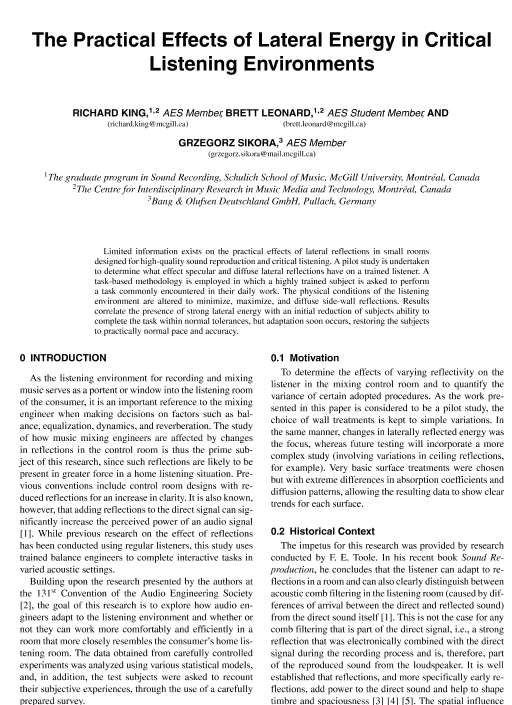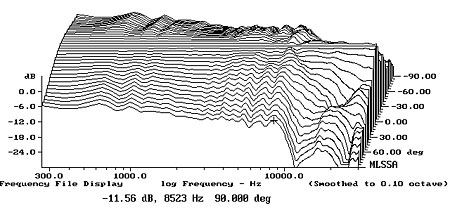"Hi Bert.
People who say I dismiss room reflections as unimportant - and there are a few, it seems - simply have not read or understood my book. It is patently obvious that room treatment is necessary, if only to establish conditions suitable for comfortable conversation. This requires reverberation times under 0.5 second. This alone, also pretty much ensures that film dialog will be clearly understood.
The most debated issue relates to first lateral reflections. Some of those arguing vociferously in favor of eliminating them seem to have a conflict of interest, being providers of acoustical materials. Others have more reasoned arguments. I say up front that there can be no universally satisfactory answer because there is no universal scheme for recording stereo or multichannel signals. Only through controlled listening tests can we get useful insights, and these are in short supply. In the meantime opinions reign supreme, and there are many of them.
In the book I show results of several double-blind evaluations, some done by me, some done by others, showing that listeners tend not to be disturbed by lateral reflections, and many even prefer them. I also point out that the professional side of the industry almost universally feels the need to eliminate them. I suggest, respectfully, that humans have a remarkable ability to learn, to adapt, and that recording engineers spending their days adding, adjusting, and removing - at will - delayed sounds from mixes undoubtedly are more highly sensitized to these sounds than are lay listeners.
This probably applies to any audio professional, acoustical consultant��r enthusiast who focuses enough attention on this task. We learn to hear things and, once heard, they tend not to go away. I well remember that during the resonance detection experiments, we all became extremely skilled at hearing and identifying resonances. During the tests, and for some
time afterward, we were hearing little resonances in everyday life that normally would have been totally unnoticed. From such things paranoia is born, and if we had taken this to an extreme, we would have damped our wine glasses.
For stereo listening I have found that it very much depends on the program. Music with lots of decorrelated sounds, classical for example, is sometimes enhanced by reflections, although coincident-mic recordings may benefit from a lack of reflections - letting the direct sounds be more dominant (the Blumlien stereo effects work best in an almost anechoic situation).
Pan-potted recordings (the majority of pop) end up delivering essentially monophonic sounds from left and right loudspeakers, and these may well benefit from a bit of spatial enhancement. Otherwise we are left with what really annoys me about stereo: a relatively spatial set of phantom images created by both loudspeakers, and two "anchor" images created by the left and right loudspeakers playing solo. In some recordings we hear a whole string section emerging from a single loudspeaker. Not realistic, and not even pleasant. In the past, I have recommended that serious stereo listeners hang absorbent drapes along each side wall, pulling them out and pushing them back to suit what they are listening to. Our listening room at the National Research Council in Canada had this feature.
In the book, I put more emphasis on multichannel audio, where much of the important sound is delivered by the center loudspeaker, farthest from the side walls. In these situations I conclude that treatment of the side wall reflections is an option. There may be situations in which their effects are audible, but when all 5 or 7 channels are operating, it is improbable that natural room reflections have much of an effect. Other things being equal, the effects of the room are most audible when only a single loudspeaker is operating, and it becomes less so as other loudspeakers (channels) contribute additional uncorrelated sounds.
Of course the degree to which reflections are activated depends on the directional properties of loudspeakers, and the extent to which the loudspeakers are well behaved in their far off-axis responses (side wall reflections can be 50 degrees and more off axis). It has become clear over the years that, with hard side walls, the more uniform the off axis frequency response, the higher the rating of the loudspeaker. So, one has to wonder whether at least some of the dissatisfaction with reflective side walls has to do the misbehaving loudspeakers. Sadly, most manufacturers don't provide us with sufficient data to judge. And that is another, and I would argue much more worthy topic, to argue about.
I too think that the "Schroeder" diffuser is not a universal solution, with uniquely advantageous properties. The "time smear" argument might have merit in specific applications but it has yet to be demonstrated in any scientific way. I think the needs of large venue "live" performances are quite different from small room multichannel reproduction. The fact that curved surfaces deliver relatively strong single reflections over wide angular ranges can, in fact, be highly advantageous in some situations.
cheers,
Floyd"



